Sanctuary of Truth, A Primer/Three Way Keyboard Shoot Out!

|
• Hintok River Camp @ Hell Fire Pass • River Kwai Jungle Rafts • River Kwai Village Hotel • Mom Chailai Forest Retreat |
I have some unfortunate news to report on this project and total 100% transparency is how I feel this should be handled. My planned beneficiaries of this project, innocent very much in need children at a certain orphanage, have fallen victim to their local manager who we have found cannot currently be trusted and I doubt this is likely to change. Decisions need to be made if we're going to carry this project forward and if so who the new beneficiaries will be. I do expect this project to generate significant revenue so I take it very seriously. As you read this I'll be back in the Mae Sot area investigating further. I'll keep you informed. For now I'll still collect images with the intention of making the best most meaningful mosaics possible and as always, I'm asking for and will greatly appreciate your help with the images.
We are still accepting (and pleading for) images of children from SEA. No matter how terrible you think
they are, please send them in anyway. These images will be used to complete a set of 3 high quality mosaics which will be sold to benefit the Karen and Burmese Orphans living in the orphanages and refugee camps. The more images the better, I can
use all you have. Please take the time to go through your images for anything you think might help. If you missed the "No Place to Call Home" special, you can
click on the link and read more about this. Thank you! info@BangkokImages.com
Quick Click Links
Feature Photograph
Sanctuary of Truth, A Primer Three Way Keyboard Shootout!
Photography News of Interest
Readers Submissions
Readers Questions A Snapshot of Bangkok Images Week in Review
Infocus Blog, Momentarily Satisfied..T
Feature Photograph *menu

Canon 1ds Mark II, 24-70mm F2.8L @F8 1/250th 32mm ISO 100
This is a recent “rework” of one of my favorite images. The original is immediately below this one and you can scroll up/down to view them both as I discuss the new image. I’m a big fan of using newer software to effect improvements on images from years past. Newer software often offers significant improvements, often making an image previously unsuitable or unusable very satisfying. In this case I always liked the image despite its flaws. Still, I always wished I could wipe away the flaws and make the image more satisfying if not better.
First, there is a huge difference between the old ACR (Adobe Camera Raw) and Lightroom 2003 raw engine and the newest 2010 raw engine. You can achieve much greater detail with less noise. Look at the two skies. Notice how in the new rendition the clouds stand out with greater detail and the highlights previously blown out are now saved? Thank you 2010 raw engine!
Also, look close up the river and you’ll see some wake. That’s a jet ski. You can’t see it well on a web size image, but on a 24×30 print you sure can. I removed the jet ski and its plume with CS5 Photoshop’s Content Aware Fill. Look in the lower left corner. See the brown top of the hat of the person kneeling next to me? CS5 Photoshop’s Content Aware Fill helped me turn it into nice green leaves.

Canon 1ds Mark II, 24-70mm F2.8L @F8 1/250th 32mm ISO 100
Finally I cooled it off (not so orange) a bit, and burned in the green water plants on this side of the river going along with the flow of natural light. It helps the image achieve a more 3D like look. And again, while you can’t see it here on the 24×30 inch print you’d certainly see a great improvement in noise reduction thanks to the 2010 engine. But is the image better?
In the areas I mentioned I think it is, but I’m not sure if changing those small things which have bothered me for years, threw off the balance of the image in a negative way? I won’t know until I look at it for a few more years. Art is like this. Often I’ll make a print and tape it to the wall and stare at it for a week or so on/off as I do other things to see if anything jumps out at me. More often I’ll bring it up on the 50” HDTV monitor for the same reason.
Is this normal behavior for an artist? I don’t know, I only know it’s very normal for me. Often when I tell a client I’d like a few more days to “process” their images it’s not because they’re not done. Its because I’ve not felt the satisfaction I want and given more time, more staring, and a few corrections.. I’ll come up with a better finished image. At least to me. I’m not sure if the client notices or not. But then I do this sort of work for me first, and the client second. I consider myself fortunate to be able to set such priorities. I’ll see you in a few years when we revisit this same image and I’ll let you know then if it’s withstood the test of time, or if perhaps software advances have made more improvements possible. ;o)
Sanctuary of Truth, A Primer *menu
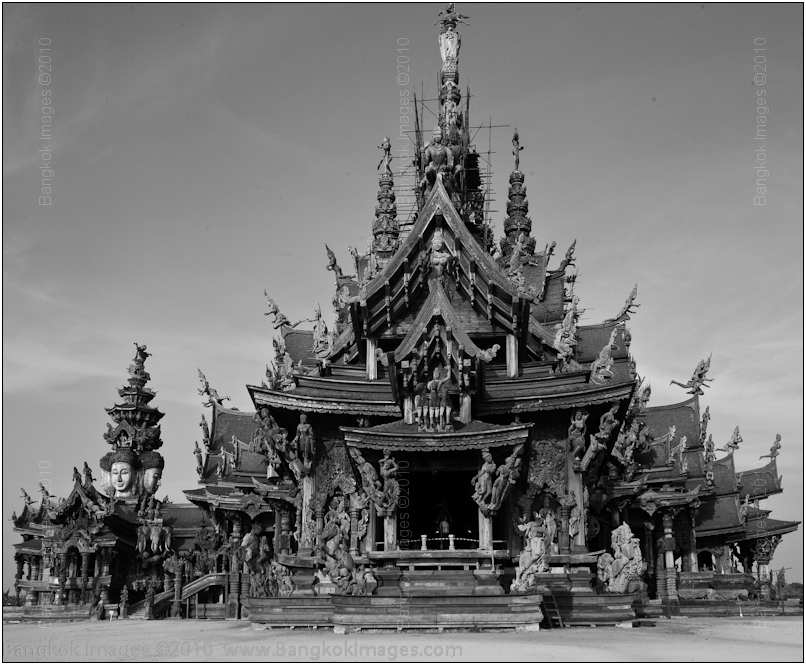
Canon 1ds Mark II, Sigma 12-24mm F4 @F11 1/250th 24mm ISO 200
As monsoon season settles in to punish us in earnest many fair weather photographers gaze out the window watching the lightning as thunder rumbles in the distance. They’re halfway glad they’re not out in the muck, and halfway bored because
there’s only so much television a creative guy can take.
I’ve long shared with you in this column that inclement weather provides prime photographic opportunities and time only reinforces this opinion. Once monsoon season is over, and the rain is no longer cleansing the smog from the skies, all we’re
left with is hot whitish boring skies. If we’re lucky. The end of monsoon season also signals the start of field burnings and a thick haze will settle over the northern cities of Chiang Mai and Chiang Rai choking its residents with the
worst air quality of the year. Thai authorities will warn us not to go outdoors, especially to exercise, and then you’ll be gazing out your windows at something entirely different!
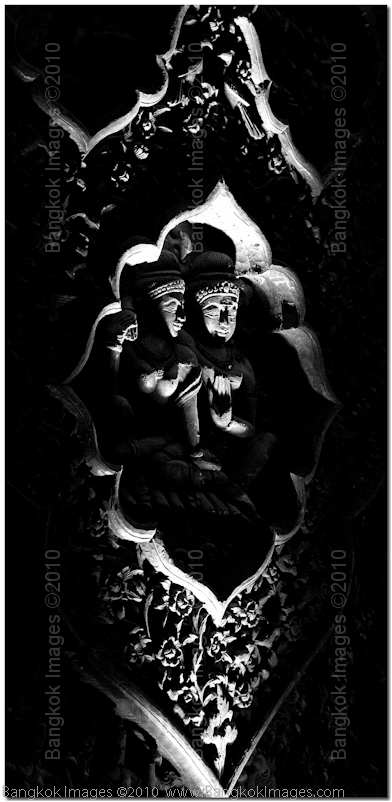
Canon 1ds Mark II, 24-70mm F2.8L @F4 1/50th 70mm ISO 1000
Perhaps one of the most difficult places to properly photograph is the Sanctuary of Truth in Pattaya. I make this one of four stops on my workshop “Pattaya Loop”, a fast paced whirlwind day taking us from Bangkok to the Khon Kheow Open Zoo , to the Siracha Tiger Zoo , ending up atthe Sanctuary of Truth.
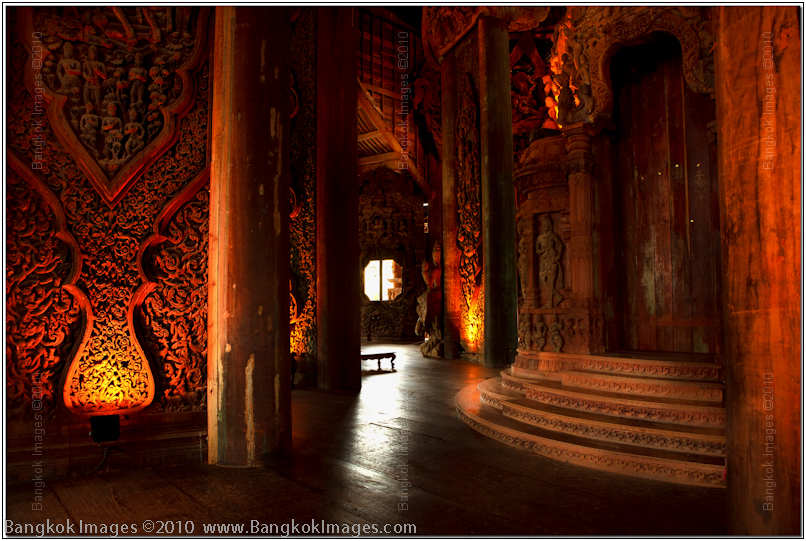
Canon 5d Mark II, 24-70mm F2.8L @F5.6 1/25th 24mm ISO 320
This is a lot of driving and a lot of photography for a single day, but fortunately it’s nicely split up into three pieces so we get some recovery time in the air conditioned vehicle..:) The Sanctuary of Truth itself is best photographed towards
the end of the day, when the heat isn’t nearly as bad and when the brightest sun is hours past.
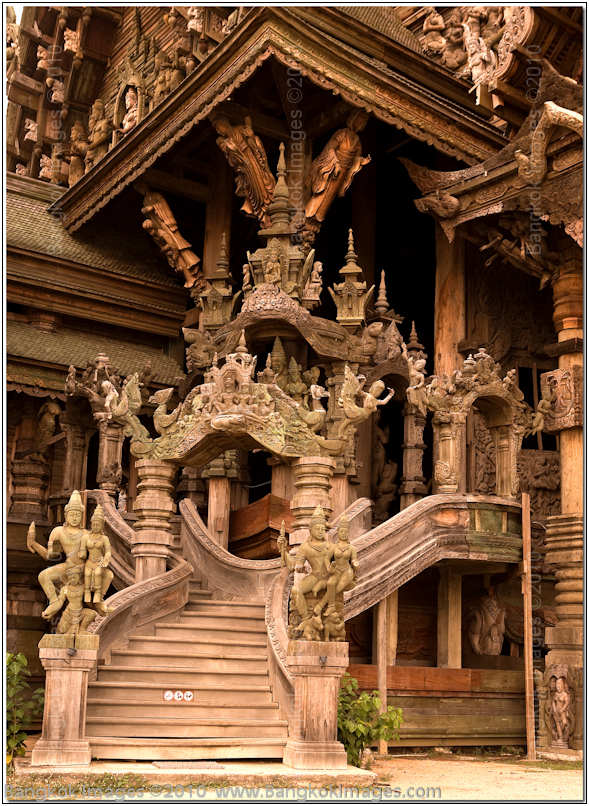
Canon 1ds Mark II, 24-70mm F2.8L @F5 1/60th 45mm ISO 100
Because of the heat, and the way it sets into the Sanctuary of Truth, and needing to be there in the last few hours of the day, two hours at this location is about all we’ll get. I’d do the same even if I was staying in Pattaya to photograph
this location every day for a week. Images from the mornings and afternoons just don’t turn out well, while the later afternoons are perfect.
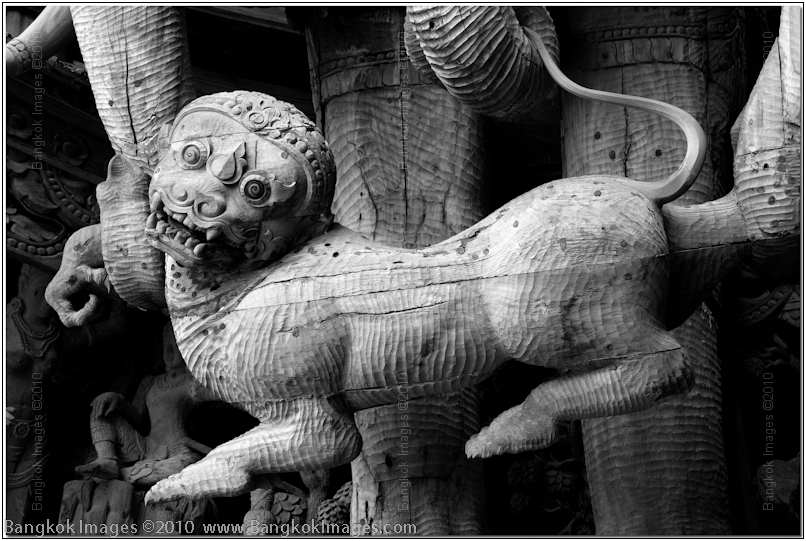
Canon 1ds Mark II, 24-70mm F2.8L @F8 1/60th 60mm ISO 400
Each piece of the SOT is made of a hand carved wood by a local artist. A large scale model is used to plan and mock things up, and the artists are on site in a covered working area turning out these pieces day after day.
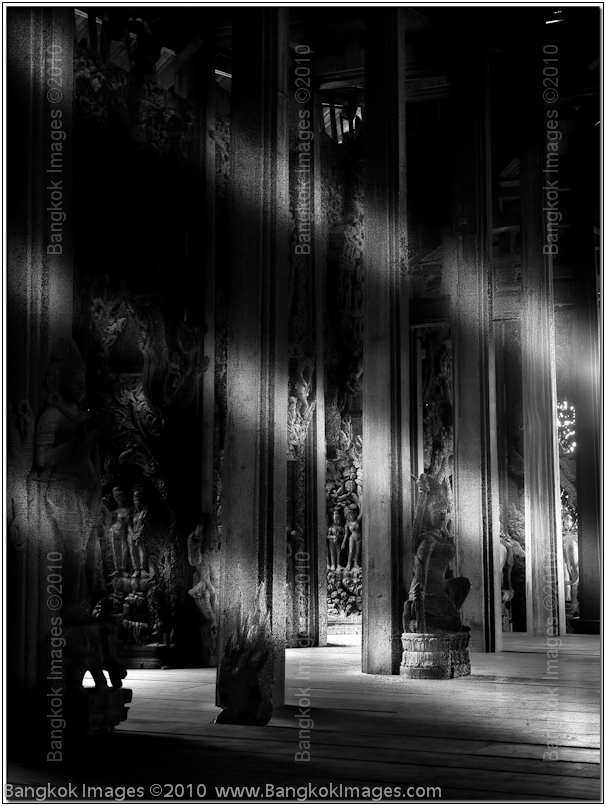
Canon 1ds Mark II, 24-70mm F2.8L @F5.6 1/40th 60mm ISO 500
If you’ve been watching the exfil shooting data I’ve been carefully placing beneath each image then you’ve noticed a wide variety of settings, lenses, camera bodies, and techniques have been employed. This is one location where you
benefit greatly from a workshop if just to have someone tell you what lens works where, where the light is coming from, what settings work best, and more.
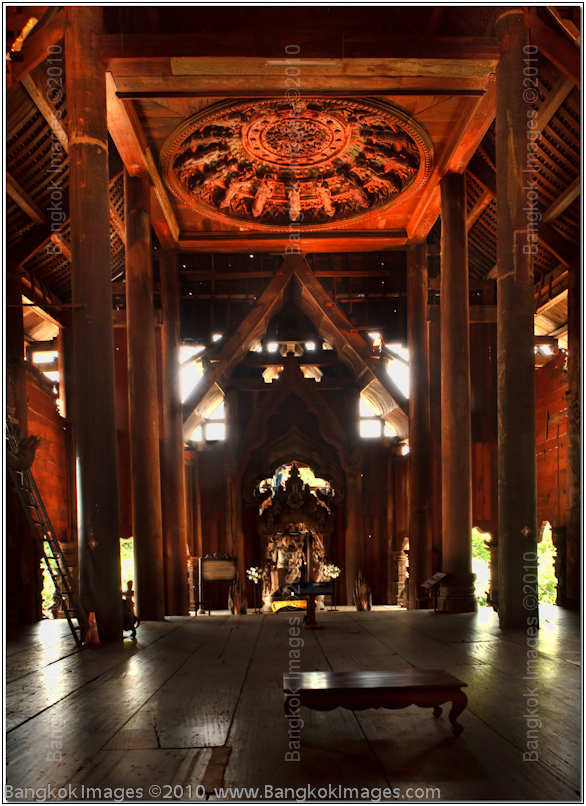
Canon 5d Mark II, 24-70mm F2.8L @F5.6 1/25th 24mm ISO 160
My passion is the interior. Rays of light mix with the darkness and the exotic carvings lending a feeling and look you just won’t get anywhere else. As you can see, even in the late afternoon it’s much brighter outside than inside, by a
much wider margin than your cameras sensor is capable of capturing. This means the later in the day you shoot, the darker the skies (think monsoon season), all work for you. Different and somewhat advanced techniques such as HDR and exposure balancing
helps a lot too.
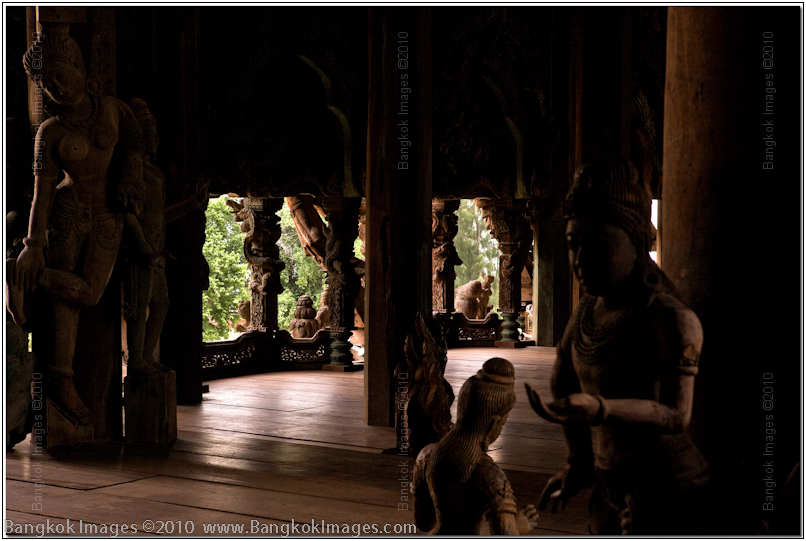
Canon 1ds Mark II, 24-70mm F2.8L @F8 1/40th 70mm ISO 400
If everything lines up near perfectly you’ll be able to get some single exposure matches between the inside and outside, but it’s always a delicate balance. You just won’t realize how much heavy dark rain filled clouds really help
until you’ve been here a few dozen times and tried everything else.
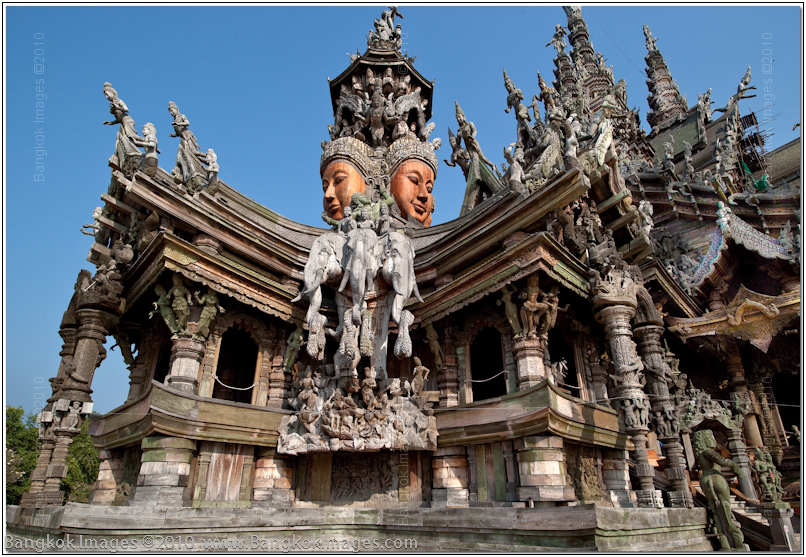
Canon 1ds Mark II, Sigma 20mm F1.8 @F8 1/640th ISO 100
Even on a cool winter day, 30 minutes before sunset, the skies will be very bright and if you’re lucky blue in color. Notice the severe angle of light?
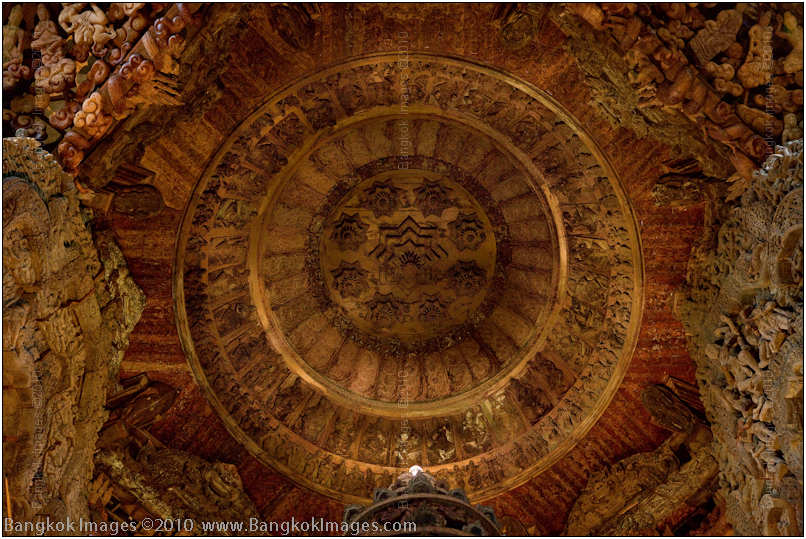
Canon 1ds Mark II, 24-70mm F2.8L @F4 1/25th 54mm ISO 800
Every inch of the ceilings are also intricately hand carved. At times I encourage clients to lay on their backs and study the ceilings and make their best captures. Laying on your back provides a great view, you can brace for some very low shutter speeds,
and it’s a bit of a rest.
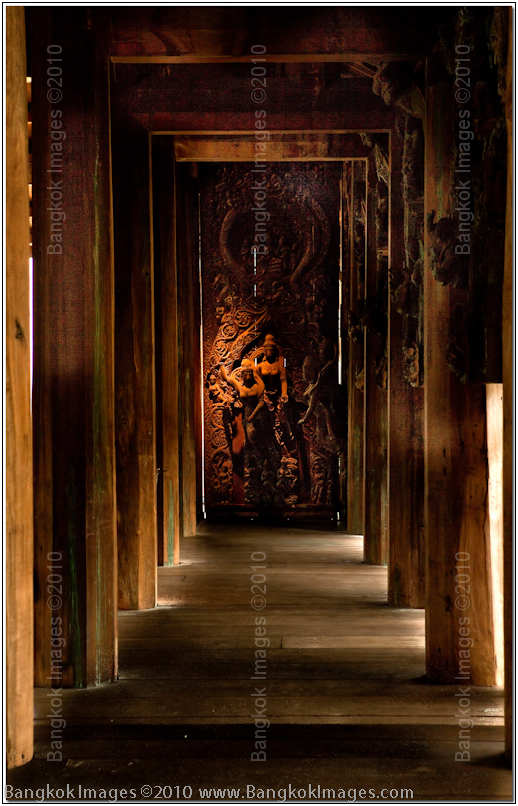
Canon 1ds Mark II, 24-70mm F2.8L @F5 1/60th 70mm ISO 400
Everywhere you look you’ll find long passages with interesting lighting, hard carvings, and a feeling unique to the Sanctuary of Truth. Not even Angkor Vat or Wat Rung Khun can give such a feeling.
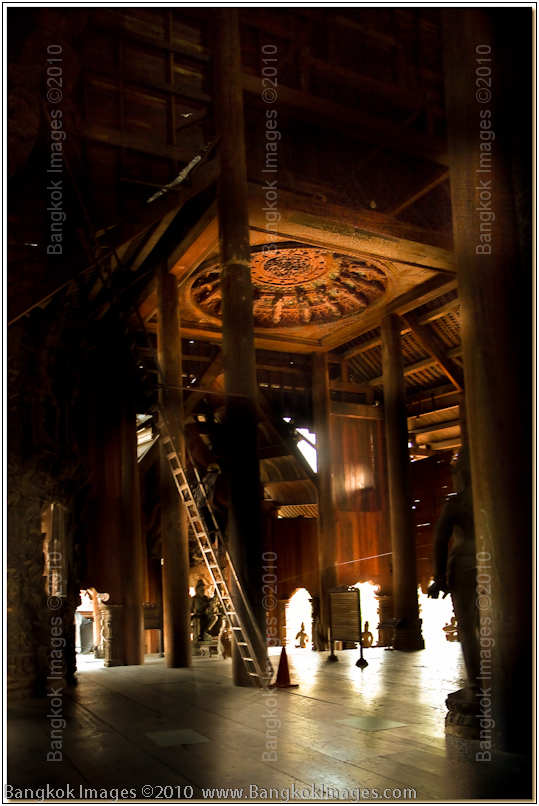
Canon 1ds Mark II, Sigma 20mm F1.8 @F2.8 1/25th ISO 100
A long wide view during the morning with a hint of fog in the capture. It was foggy outside, but still very bright. This was during my learning process before I learned the best time of the day is the late afternoon.
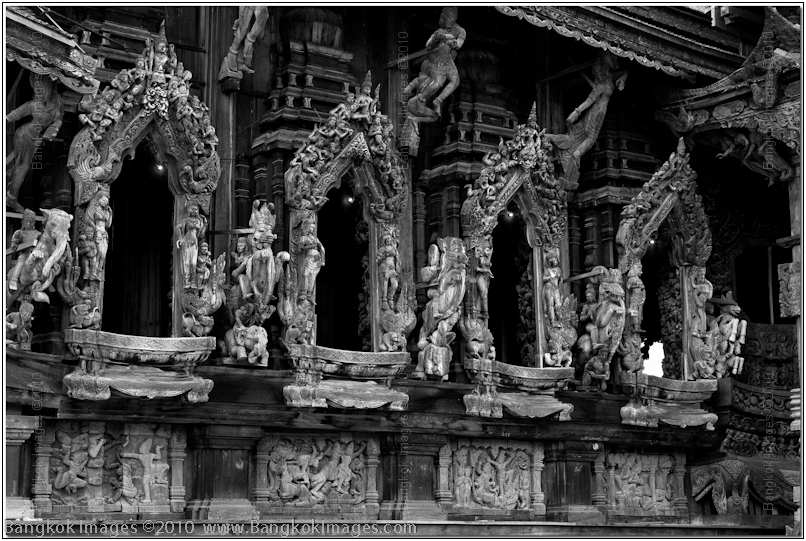
Canon 1ds Mark II, 24-70mm F2.8L @F8 1/40th 67mm ISO 100
The exterior is overwhelming. Usually you don’t know where to start. Every square centimeter of the place is covered in an interesting carving and it isn’t until your 3-4th trip there that you begin to ‘section’ the exterior
in your mind, isolating different views.
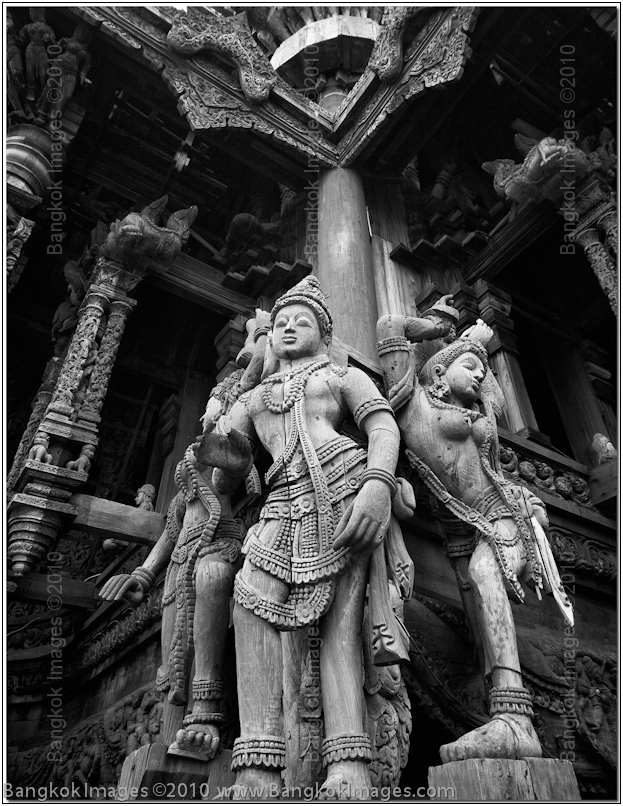
Canon 1ds Mark II, Sigma 12-24mm F4 @F8 1/30th 24mm ISO 200
We’ve mentioned before how your eyes see 15-17 stops of light, and your cameras sensor only 5-7? It’s a challenge to isolate scenes where the sunlight naturally models the carvings in a way very similar to the way you use strobes to model
a live subject in the studio!
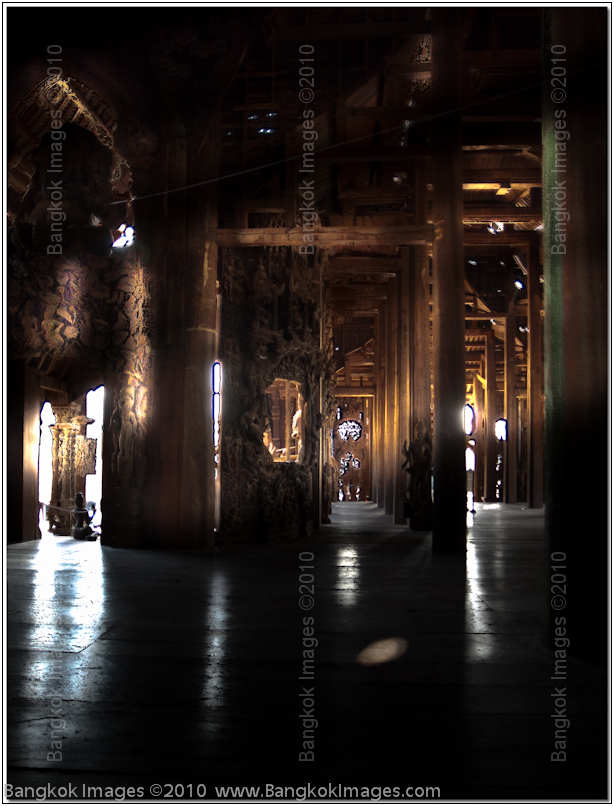
Canon 1ds Mark II, Sigma 20mm F1.8 @F2 1/20th ISO 100
It’s a lot of fun to capture the light rays during the last light of the day. You’ll need to balance your exposure almost perfectly, but if you take the effort and if you can stand still in the same place and watch the light change slowly
at first, but as it reaches it apogee much faster, then you can make such captures.
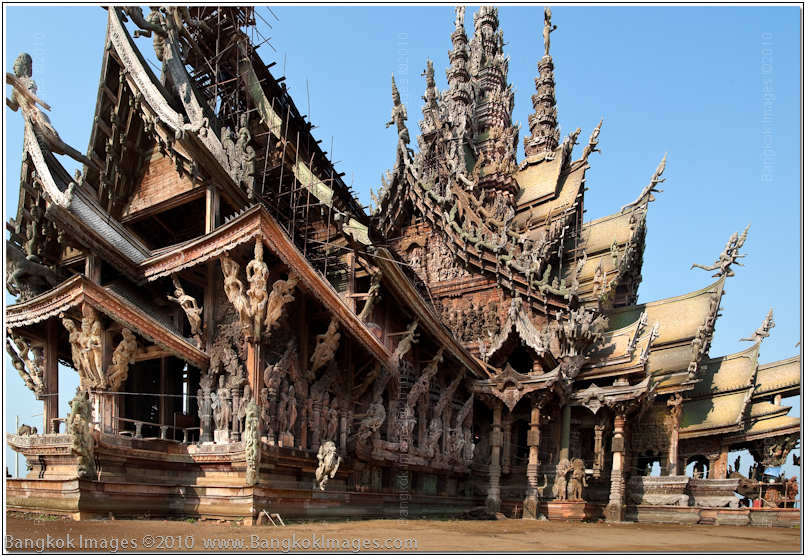
Canon 1ds Mark II, Sigma 20mm F1.8 @F8 1/160th ISO 100
Other times it’s fun to see how wide and how close you can get to the main structure. Sure, I could have fixed the perspective in CS5, but then sometimes perspective distortion lends a ‘look’ you wouldn’t otherwise
be able to achieve.
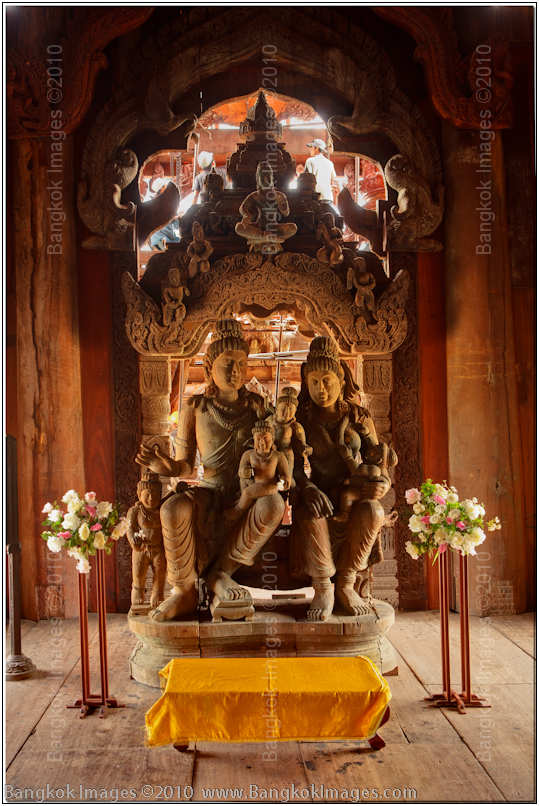
Canon 5d Mark II, 16-35mm F2.8L @F5 1/30th 35mm ISO 800
Depending on the holiday, season, and so forth the staff will put out flowers and silk which very much contrasts while enhancing the normally utilitarian view.
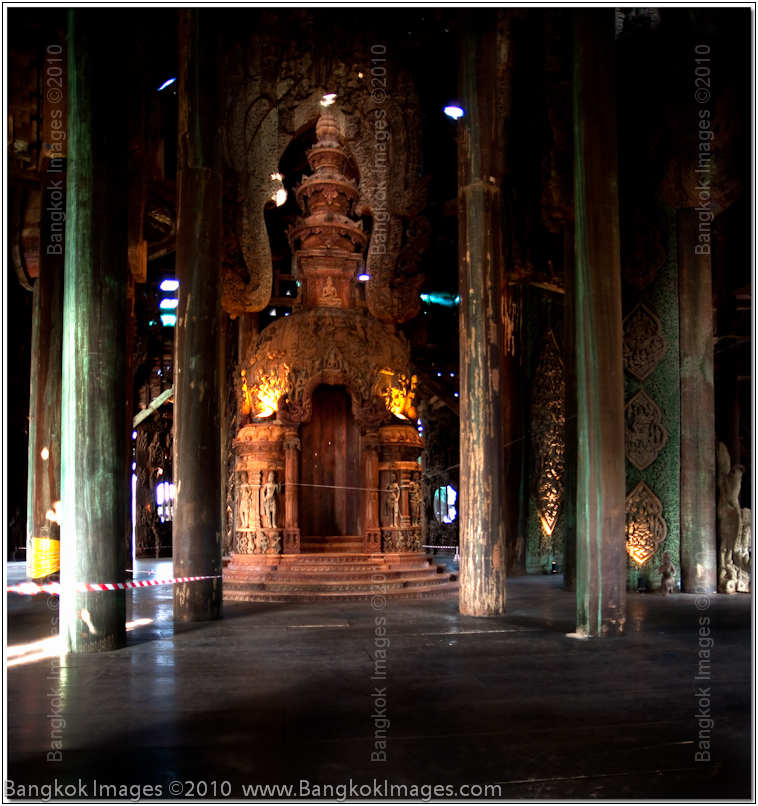
Canon 1ds Mark II, Sigma 20mm F1.8 @F2 1/25th ISO 100
After you learn your lenses and views, then you’ll start to acquire favorites. The inexpensive Sigma 20mm F1.8 lens is a favorite of mine inside darker temples, caves, and other such places you’ll often find within Thailand’s borders.
So much so, that this lens is almost always in my bag.
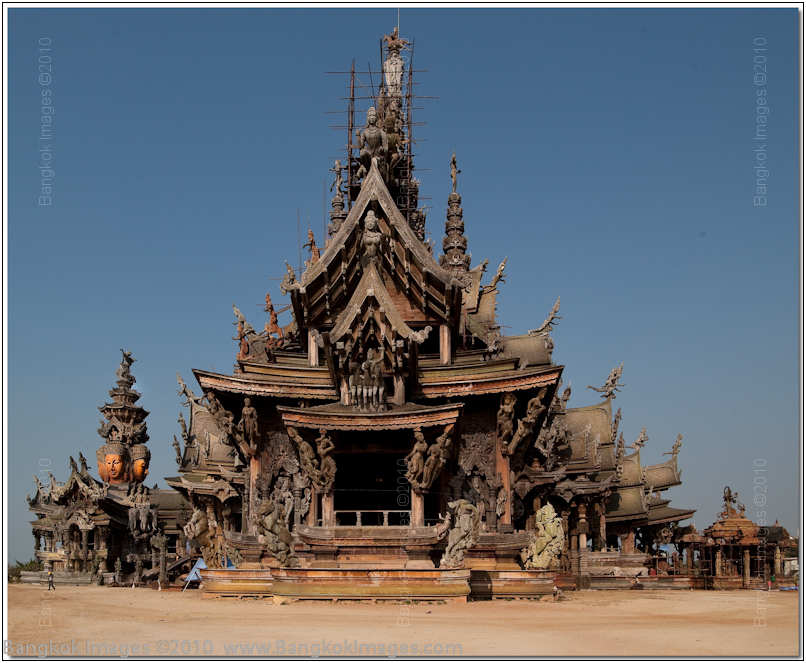
Canon 1ds Mark II, Sigma 20mm F1.8 @F8 1/500th ISO 100
Did I motivate you to get out of the house on the next rainy day and head to the Sanctuary of Truth? How about the countryside? Inclement weather opens many possibilities. Take advantage of them and send in some images to share. Biker Bart has really
been pulling the entire load of the Readers Submissions area for awhile, and it would be great to see more work from a wider variety of people. I hope you've enjoyed yet another brief look at a really great place to photography.
Three Way Keyboard Shootout! Reviewed *menu
Introduction
I’ve long advocated quality input and output devices and have previously done reviews on both Logitech’s MX100 and Logitech’s Revolution and Logitech’s MX Performance Mouse.
The power of the computer is important, but what you really live with on a day to day basis are your input and output devices. Quality monitors can make a huge difference in your work, both for the proper matching of colors and to reduce eyestrain. Quality mice allow you to make small changes in your images, brush colors, blend, and manipulate your workstation environment. We use mice perhaps more than any other input device so we should use good ones. Keyboards are more single purpose, we use them to input letters and numbers and to a much more limited extent to ‘hotkey’ functions such as volume, search engines, zoom, and more.
Keyboards are very personal in nature. I learned to “keyboard” in 5th grade in formal typing classes on an old full stroke Underwood manual typewriter. We learned our ‘home keys’ and where everything should be, and to this day not much has changed. Our home keys are still in the same place and still marked by tiny lifted nudges on your F and J keys, a tactile reminder of where to place your hands so your muscle memory can take over for the purpose of ‘touch typing’.
A general observation is the more detailed your work, the more you require from your mouse. The faster and more you type, the more you demand from your keyboard. And you should.
Still, we all have our favorite type of keyboard. For the longest time I was a fan of the mechanical switch keys you’d find in the very old IBM keyboards or Keytronics keyboards. You remember these, 20 pound heavy metal keyboards that made a loud clacking noise as you type? Yes, you can still buy mechanical switch keyboards, a good one is about $150 and made bya German company Das Keyboards.

Later I moved to laptop like keyboard made by IBM. The current model might be better than when I was using them, but I found although they very closely replicated the look, feel, and key placement of IBM’s excellent ThinkPad keyboards, they weren’t nearly as durable. I still have 4-5 of the things around here somewhere and I’d buy them 2-3 at a time. Eventually I found something better.

My former housekeeper, bless her heart, learned my business very well and noticed I always used the same keyboard. One day while visiting a tech show she found one she thought I’d like better. At first I didn’t take her too seriously but she persisted and soon we found ourselves at Pantip Plaza checking out the Logitech diNovo Edge Bluetooth keyboard. At first I thought its built in touchdisc would be the equal of the touchpad on the IBM but it wasn’t nearly as good. However, the keys and keyboard layout were ideal. The Bluetooth wireless was liberating. This became my keyboard for the next four years, but unfortunately it didn’t last forever and I recently found myself looking for a replacement. Let’s talk a bit about each one.
The Competitors
Logitech diNovo Edge Bluetooth

The diNovo Edge is quite the keyboard. If it was still a current model I’d probably have spent another 10,000 baht for another. I’ve been told they’re replacing it soon so I decided to look further. Still, its available out there at discounted prices (in the states) so maybe someone will want to scoop up a deal.

In addition to being wireless and Bluetooth compatible it’s also rechargeable. I use my keyboard a lot and I routinely got 30-45 days on each charge and this didn’t diminish during its lifespan like you’d expect it to. Every month or so I’d set it in its charger for a few hours and that kept the batteries topped up. The Bluetooth allowed it to be connected to my workstation via its included dongle, or to my laptops via their built in Bluetooth interface. The TouchDisc was ‘usable’ at best, annoying at worst. The media controls including the volume slider worked well, but weren’t something I used often.

The two areas I really appreciated were its great looks including the slim design and black Plexiglas cover, and it’s “Perfect Stroke” keys. The keystrokes are quiet, have just the right amount of over travel, and a tactile feedback which I find very comfortable. The Perfect Stroke keys remind me of the old mechanical keys of old, but without the noise. Very comfortable!
Logitech diNovo for Notebook

Another soon to be discontinued but still available keyboard it the Logitech diNovo Notebook. I ordered this because I found a closeout for $45 and after examining it in person I can’t figure out why it’s classified “for notebooks.” It’s the same full size and layout as the diNovo Edge above.

The diNovo Notebook edition uses replaceable AAA batteries (2) and is not rechargeable. It’s estimated to last 4-6 weeks on one set of batteries. This might not be very green, but it’s certainly convenient and you don’t need to place or store a big bulky charging station like with the Edge.

It’s got the same great style and slim design, but adds a numeric keypad while deleting the media controls and TouchDisc over the diNovo Edge. Fine with me, both features I didn’t use.

The Logitech diNovo Notebook uses the same great Perfect Stroke key system. For $45 its one heck of a buy. You’ll find them on closeout in the states if you look. I found mine on Amazon.
Logitech Illuminated Keyboard

Typing in a specification comparison for all keyboards using the Perfect Stroke system I found only three. I owned one, had ordered the other, so why not add the third to my order? This one is very simple but as close to perfect a retail price of $79 can bring.
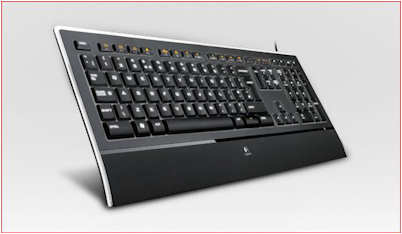
It’s very thin yet reassuringly solid. It’s 100% plastic and doesn’t have the aluminum solid frames of the diNovo series, but it flexes very little. The layout is the same as the diNovo Notebook, a separate numeric keypad, full size layout, and dual function/media keys across the top.

What sets this apart and makes it different is that its illuminated via laser etched cutouts on each key. You can set the level of brightness using the illumination key, there are four levels including off. Even though I’ve touch typed for years I found the backlighting welcome. After a bit of use I actually grew to depend on it. Nice.
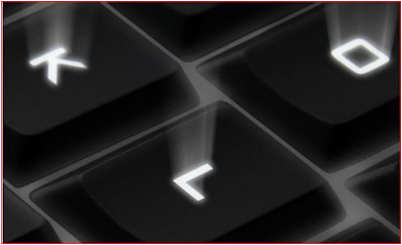
All in all a very nice keyboard and no need to worry about batteries or recharging. Sure, the USB cord is there but I suppose I could get used to it. ;o)
Summary
I’ll admit it, looking at these three keyboards I wondered why Logitech didn’t make a keyboard incorporating the great aluminum frame, slim style, rechargeable or replaceable batteries, perfect stroke keys, separate numeric keypad, and wireless. And while they’re at it, why not make it compatible with the unifying receiver my MX Performance Mouse uses so I can regain a USB port?
However, at the time of ordering there were only these three models available. Looking at these three models I feel it’s a matter of choosing the features you most enjoy or need. Do you need illumination, wireless, a separate numeric keypad, solid aluminum frame, choose what you need and then look for the best price. These keyboards are all way better than anything that came with your PC or Mac, and yes they make a Logitech diNovo Mac, though its discontinued so you’ll need to look around for one. The important thing is the full size layout and the perfect stroke key system. Now I have three choices.
But guess what? Just as soon as I used these enough to have an opinion, Logitech announces its new K800 Illuminated Wireless rechargeable keyboard with a strong aluminum frame and laser etched keys. And it’s even compatible with their unifying transceiver! Shoot me now..
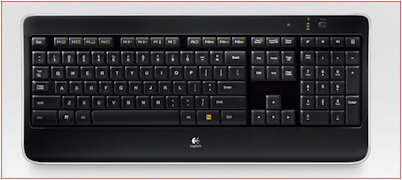
This will be perhaps the best keyboard of all time. Sites everywhere are already speculating. The slim design is really enhanced by the backlit keys.
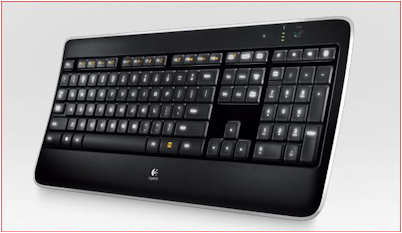
The perfect stroke system remains, and so does the separate numeric keypad. The illumination is adjustable, and it even turns on/off automatically as it detects your hand getting close. This saves on batteries.
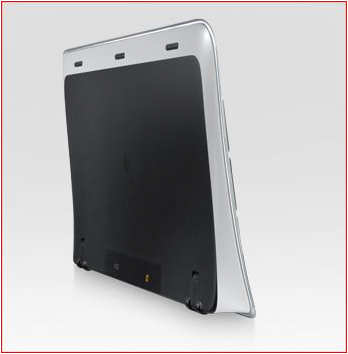
And speaking of batteries it uses two rechargeable and replaceable AA’s which can recharge using a simple USB cable while keeping the keyboard active and in use, or you can even choose to use replaceable alkaline AA’s. Your choice.
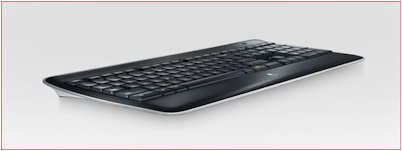
The slim design appears a convergence of all three previous models and I really like it. It can sit on its own edge, yet is tilted just perfectly for typing. I haven’t felt one yet, but I’d imagine it has significant heft and feels great.
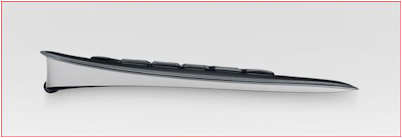
Isn’t this exactly how I ended up with my MX Performance Mouse? I was happy with the Revolution, it got old, I tried the MX1100 because it was the closest thing available, and then the made the Performance Mouse available. DAMN YOU LOGITECH!!!
I preordered my K800 Illuminated wireless keyboard with perfect stroke keys and separate numeric keypad. I suspect I’ll actually get my hands on it in the middle of September. I’ll use it a few months and then let you know how great it is. Oh, almost forgot. It’s not $200 like the original diNovo, it’s only $99 list which is an incredible value.
Not the review you expected? Sometimes things go this way. Either way, I hope it prompts you to look at your own keyboard and evaluate it for your needs. The art and even the competition of building the perfect keyboard is alive and strong.
Photography News of Interest *menu
Sony announces both the DSLR-A580 and DSLR-A560 DSLRs featuring the 16.2mp and 14.2mp sensors respectively. Full
1080p movies, fold down LCDs, ISO capability to 25,600, in Auto HDR, and more. Much more These entry level DSLRs have a ton of leading edge features.

Sony releases three new prime lenses. The Carl Zeiss Distagon T 24mm F2 SSM, the 35mm F1.8 which is a fast ‘normal’
lens for a crop frame (APS-C) sensor, and the 85mm F2.8 SAM, a small portrait lens. Check them out.

These releases will be important.
Sony unveils the SLT A55 and A33 base level DSLRs with the TRANCLUCENT MIRROR TECHNOLOGY. What this means is a small amount of light is allowed past the mirror and used for full time autofocus allowing a very fast 10fps and full time autofocus
during video recording. Sure, we’ve seen 10fps cameras before, but not at the $649 prince point! Digital Photography review does an in-depth review of the Sony SLT Alpha A55 here.


Canon develops a 120mp, yes a 120 megapixel APS-H sensor. 120mp’s is incredible and fun to think about, but don’t expect to see on in a camera for quite some time.

Remember a few weeks back I linked you to the newly discovered Ansel Adam’s glass negatives found at a garage sale? A group representing Ansel Adams claims it’s a hoax and
sues a company from marketing the images using the name or image of Ansel Adams. Read about it here.

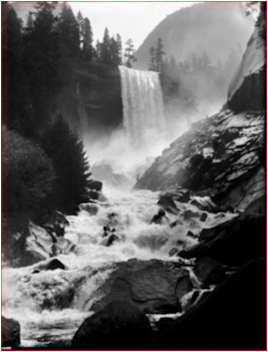
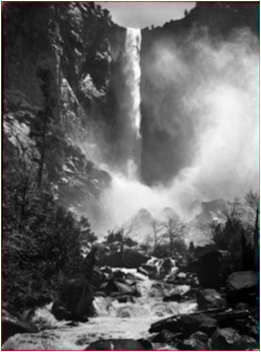
A few years back when my son was heading to Iraq I sent him a very tough water proof, shock proof, and shock proof Ricoh. It survived that tour and the next and he recorded some decent
images and short movies with it. Ricoh announces their latest camera with these features in mind . If you need a very tough go anywhere camera give this one a look.

A big week for Canon as they announce their new redesigned EOS 60D. Canon redesigned and repositioned this EOS 60D
in their lineup, making it less expensive, smaller, and more capable. 18mp, high-rez 3” LCD which is an industry first fully articulated. Incredible amount of movement.
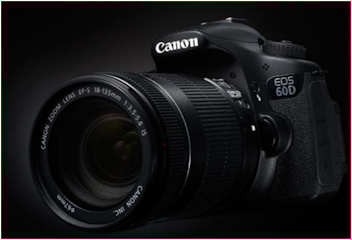
Canon releases the EF 70-300mm F4-5.6L IS USM zoom lens. This focal range has been tried many times before, never resulting in anything stellar. The best even done in the 70-300mm range was Canon’s own 70-300mm F4 DO IS lens and this is still a current model. I’m not sure where this new lens comes into their lineup, but I’m guessing below the DO model.
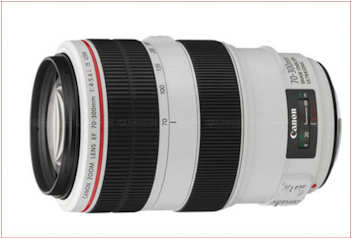
Canon announced and released the EF 8-15mm F/4L USM Fisheye Zoom Lens. A fisheye zoom? Yes, another industry first. At first glance you have to wonder why, but it’s probably for those automating panoramics and 360 degree VR movies for high end real estate and other ‘walk through’ photography products. It should be interesting to see how the respective professionals in these areas make use of this lens.
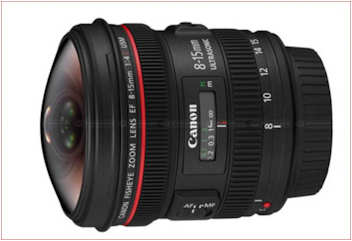
Canon introduces the updated versions to their EF 300mm F2.8L IS II and EF 400mm F2.8L IS II lenses. Canon’s 300mm F2.8L IS has long been considered perhaps Canon’s sharpest lens ever, and certainly it’s fastest focusing. Able to capture an extreme amount of detail on a darkened sports field from a distance while activating all the cross-type sensors with it’s F2.8 aperture.
Canon enhances this lens with its newest IS (4 vs. 3 stops from the previous model), and a bit less weight, and the AF uses new algorithms with a newer faster CPU which ‘should’ equate to even faster AF than ever before. If you’ve ever used the original, it’s hard to imagine faster AF. What really gives me pause is the $7000 USD price. I tell people you’ll rarely lose money purchasing a top quality lens and this is a great example. Last week the original listed for $4500, up from $3500 the year before. Now with the replacement at $7000 I doubt you’ll see an original go for under $5000. That would be $2000 more than I paid for mine (new) six years ago. Btw – This lens is great, worth every penny.
Canon’s 400mm F2.8L IS has long been recognized as way too heavy and not very useful, often bringing discounted prices for resale, and meanwhile Canon’s 400mm F4 DO IS lens did great with its much lighter weight and shorter barrel. The new 400mm F2.8L IS II drops an amazing 28% of it’s weight! Perhaps that’s enough to make this lens useful, the F2.8 aperture will certainly be appreciated if it is!
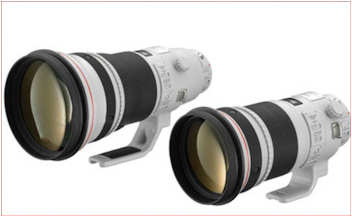
Canon also releases their updated 500mm F4L IS II USM and 600mm F4L II USM lenses featuring a bit less weight and new lens coatings. These also get the newest generation of IS with a 4 stop advantage, and while they haven’t listed the new prices, with the 300mm F2.8L IS II USM going for $7000 you can expect these to exceed $8000 and $10,000 respectively. We’ll see.
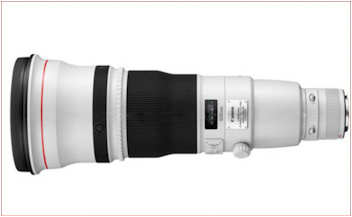
Canon updates both it’s teleconverters, the 1.4x III and the 2x III. Heck, I’m still using
a 1.4x original and a 2x II. These ARE NOT your off-brand substitutes. These are matched to Canon’s great telephotos and provide great image quality. If you’re in the market for teleconverters for your Canon, these are the ones to
get.
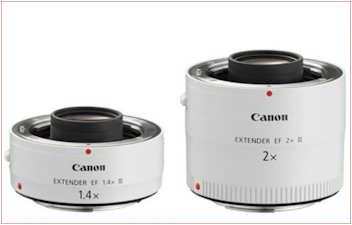
Readers Submissions *menu
Steve;
Last Saturday went to his shop to deliver some mail.
He happened to be working and gave us a tour.
Cool – that first green car cost 1.8 mil USD to build. Prototype.
Five were built after that and sold for about $300,000 each.
Bart








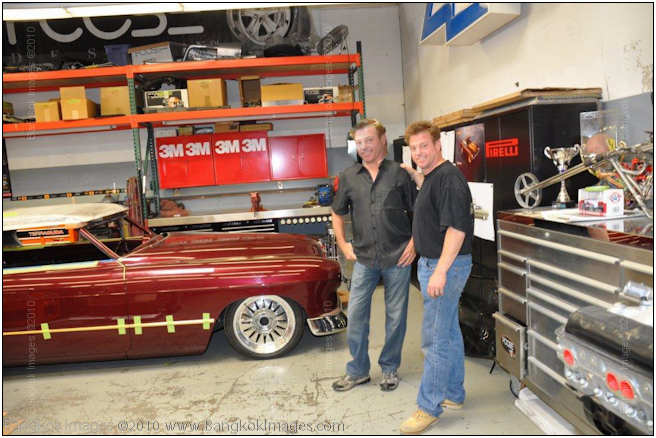
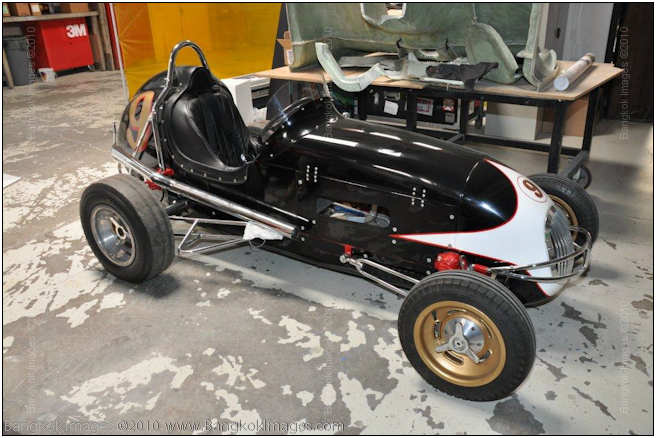
Bart –
You really get around! And I’m not even publishing the most fun stuff you submit. (suffice it to say that Bart has more fun with a camera than any other ten men still alive today) Chip Foose. Sometimes
I can’t decide if he’s a real person, or a creation. I do enjoy the shows where he works with his father on a project.. those feel very real. Really enjoyed this set.
Steve
I suspect the readers submissions will be a highly anticipated section of this column and I encourage anyone with photographs and travel accounts they'd like to share to please send them to me at: info@BangkokImages.com
Readers Questions *menu
Hi Steve,
I read a while ago in your weekly that you used a program to do a complete HDD backup.
I want to backup my C drive with XP on it to a spare HDD so that I can install Win 7.
If things go wrong I can just plug the old HDD and keep working with XP?
By the way is there any simple way of doing a photo montage or collage in Photoshop, I want to make one with about 20 photos of our daughter.
Charles
Hi Charles –
1. I use Norton Ghost 15. It’s Win7 compatible. If you’re only concerned with backing up XP on a one time basis, a bargain copy of the previous versions of Ghost might be available for less money. Acronis also offers a well regarded program called Acronis True Image. The first 30 days are free so you could make an image and then install Win7 in that 30 day window without registering/paying for the program. Nothing will go wrong.. and I’d highly recommend you go to a x64 version of Win7.. it’s a great upgrade.
2. No.. no simple way. The easiest way to do this is to make the images the same size, say 640×480. Same perspective, same size. Then increase your canvas area to be able to hold the images in a 5×4 image frame. Doing the math this makes a canvas of 3200×1920, or a 4×5 frame which would be 2560×2400. Choose your perspective. Then allow for a small number of pixels between each image, start with 5 and go up and down from there. You can also just make a big canvas like 5000×5000, put your images together, and then crop to taste.
I hope this helps
Steve
Please submit your questions to info@BangkokImages.com All questions will be answered and most will show up in the weekly column.
A Snapshot of Bangkok Images Week in Review *menu

This week there were no workshops and not much happening other than my ongoing software and equipment reviews.
The “What’s New” area of our site continues to grow in popularity. The forums are starting to take off a bit too. We try to update the What’s New page several times a week and provide either an interesting new image or something of interest. Check it out to keep track of Bangkok Images exploits and commentary throughout the week.
Still a ton of hardware and software reviews being formed, and admittedly I’ve been taking my time with some of this gear. Some like our new monitors is just too important to rush. Before someone takes my recommendation to purchase a baht 50,000 monitor I’ll be making sure it’s a very solid recommendation. The same with some of the other gear we have in the pipeline. Please be patient, we have a lot coming and only so much space in the column each week to post it.
g, Momentarily Satisfied
Infocus Blog, Momentarily Satisfied *menu
This might turn out to be a touchy subject with some but I’m going to approach it anyway. Carefully. Exactly what is it in life that keeps us motivated towards the enjoyment of life? What I’m talking about, is what is it that makes us look
forward to living, to wake up every day excited about life and looking forward to the next day? I’m sure we can all remember the excitement of certain days in our childhood where we couldn’t wait to go to sleep, because when we woke
up we knew it would be Christmas morning, our first day or school, or perhaps we’d be getting a new bicycle?
As we get older such excitement becomes much more difficult to generate and even the general question of “why do I even exist” starts to present itself. Logically, because as adults we have much more control over our lives
than we do as children, it should be easier to maintain that excitement. But we all know it’s a rare adult who exhibits the same zest for life and excitement for a new day as does a happy child. Why? What is lacking in the life of most
adults which stifles or attenuates these feelings? I’m sure this question could keep the average shrink busy for a lifetime. Let’s try to simplify and summarize the answer.

Bridge Over River Kwai
I’ve always believed, in addition to much more, life consists of a series of goals. Short, intermediate, and long term goals. Some are immediate such as eating lunch, and some can only be realized through the living of life.. such as an academic
degree or even becoming a parent. There are some things you just can’t decide at the last second you want, and then have it happen.
Sure, if you have unlimited financial resources you can ‘buy’ most anything in life. You can buy the fanciest sports car as easily as the Average Joe can buy a cup of coffee. You can even arrange to have a family installed
in your home. I grew up in perhaps the richest area in the USA and knew many people capable of ‘life forming’ in this way, yet I’m solidly of the opinion the most unhappy people I’ve known in my life are the
richest. The happiest I’ve ever experienced have often been the poorest. And yes, of course we’re talking about being rich or poor in terms of financial wealth. But perhaps we shouldn’t.

Crater Lake Oregon, 10 Seconds of Sun
The cliché, “it’s not the destination, but the journey which provides the most satisfaction” holds true in many if not most cases. Disneyland was nice, but what I really remembered from our family vacation was
all the time in the car together, the shared meals at rest stops, the small yet interesting places we visited along the way. The time we spent together as a family, we might have spent 4-5 times longer on the road getting there.. than we spent
at the destination. Of course this isn’t always the case, but isn’t it interesting the ratio is so heavily influenced by our level of wealth?
Those with much wealth are able to skip the less exciting periods of life, and replace them with faster travel, immediate access to material possessions, and even accelerated personal relationships. But I ask you, can a person really appreciate the value
of what they have, whatever it is, if the ‘essence of earning’ never took place? If the journey never took place, can we truly appreciate the destination?

Angkor Vat Cambodia, A Cloud Break During A Rainstorm
We’ve heard the term “she’s really grounded” before. Grounded: Someone well aware of not only what they have, but what the people around them have, and who chooses a balanced approach. I think most of us can recognize such attributes in others, and we are probably of the opinion they’re a happier person for their efforts.
Is the key to life merely a balanced approach to managing your goals? To ensuring you balance the experience of the journey, with the joy of the destination? Is self-happiness simply tied to the satisfaction we achieve through the earning process? If
so, let us not cheat ourselves.

Sanctuary of Truth, Ultra Wide Perspective
Example: I remember waiting weeks for my first SLR film camera to arrive from Japan to my location in Cuba. Every mail call would find me eagerly asking the mailroom clerk if there was a package for me. Heaps of disappointment and anticipation and dreaming,
followed by the excitement of finally being handed the small brown paper wrapped box, followed by the hours of carefully opening the box and reading every word of the instruction manual. Followed by months of using that SLR with its simple kit
50mm F1.8 lens before satisfying myself I’d uncovered all its secrets.
Compare this to the time I switched my professional gear from Nikon to Canon. The replacement gear arrived over the course of a three day period, large boxes full of it, 4 bodies, 12-15 lenses, 3 flashes, tons of accessories, and stacks of instruction
manuals. Frankly it was a stressful time, I needed to get all this gear setup and incorporated into my workflow ASAP, otherwise I’d lose business and therefore my livelihood.

Chiang Rai, Timeless Fisherman
What a difference! I derived immeasurably more enjoyment from a simple $200 SLR, than from a $84,000 stack of camera equipment. The difference was in my choice of journeys. Sure, you could say that because it was my work it was necessary and that would
be true. But it’s also true that because of my work, and whatever benefit I gained from the work, I lost the experience of the journey.
By now it’s obvious life is finite, there is only so much time in a person’s life for whatever they choose to fit into that life. Could it be argued that several long and meaningful journeys will ultimately make a person more happy, and
by happy I mean really looking forward to the next day, than a great number of destinations?

Chiang Rai, Sun Breaks Front & Rear
I think this would support my observation of the rich and poor people I’ve known in my life. Yet, our modern media orientated world convinces us through a series of fleeting sound and video bites, that it’s all about the destination. Because
of modern media we tend to look at life through the same filtered glasses. We learn to judge happiness not by observing the journey, but by noticing the destination. The expensive nice car, the glitzy house, the fine clothes, and all the trappings
of wealth as they float through our view in small periods of observation. How can we possibly learn to look forward to the next day, when we’ve been conditioned to only look at today?
This segues us into our photography (you knew it was coming..:). I ask you, if we’re not participating in the journey then how the heck are we going to photograph it? If you look at the images which have withstood the test of time,
Ansel Adam’s Moonrise for instance, or his Winter Sunrise.. they’re small carefully selected slices of the journey. What about all the ‘flash’ photographs used in the media and advertising
to entice us into straying from our journey and buying the destination? Frankly you won’t remember them tomorrow. Nice, flashy, colorful, but ultimately meaningless.

Beung Boraphet, Last Bird Standing
Is it necessary to adjust the way we experience life, to really adjust our photography? To make our images more meaningful and likely to withstand the test of time? You only need to look around your own home for the answer. What personal photographs have
been on display the longest, and were they photographs of the journey or the destination? This raises my last question, do enough destinations, a journey make? Look forward to tomorrow, it’s yet another day you’ll have the opportunity
to make the meaningful capture that won’t go in the lonely drawer or dusty box, it will stand the test of time on display in your life..
Until next time..

Mae La, Boy Behind The Wire




